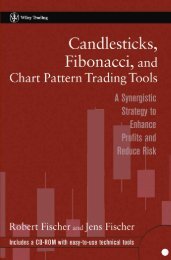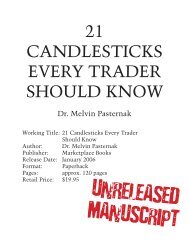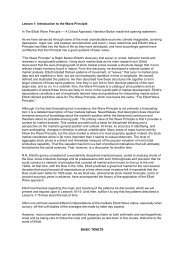The Ultimate Technical Analysis Handbook - Tradingportalen.com
The Ultimate Technical Analysis Handbook - Tradingportalen.com
The Ultimate Technical Analysis Handbook - Tradingportalen.com
You also want an ePaper? Increase the reach of your titles
YUMPU automatically turns print PDFs into web optimized ePapers that Google loves.
Chapter 5 —How To Apply Fibonacci Math to Real-World Trading<br />
Who Was Fibonacci and Why Is He Famous?<br />
For a brief history on the Fibonacci sequence, here’s an excerpt from Section V of<br />
Trader’s Classroom Collection: Volume 1 (pp. 20-21):<br />
“Leonardo Fibonacci da Pisa was a thirteenth-century mathematician who posed a<br />
question: How many pairs of rabbits placed in an enclosed area can be produced in<br />
a single year from one pair of rabbits, if each gives birth to a new pair each month,<br />
starting with the second month? <strong>The</strong> answer: 144.<br />
“<strong>The</strong> genius of this simple little question is not found in the answer but in the pattern<br />
of numbers that leads to the answer: 1, 1, 2, 3, 5, 8, 13, 21, 34, 55, 89, and 144. This<br />
sequence of numbers represents the propagation of rabbits during the 12-month<br />
period and is referred to as the Fibonacci sequence.<br />
“<strong>The</strong> ratio between consecutive numbers in this set approaches the popular .618<br />
and 1.618, the Fibonacci ratio and its inverse. (Other ratios that can be derived from<br />
non-consecutive numbers in the sequence are: .146, .236, .382, 1.000, 2.618, 4.236,<br />
6.854…)<br />
“Since Leonardo Fibonacci first contemplated the mating habits of our furry little<br />
friends, the relevance of this ratio has been proved time and time again. From the<br />
DNA strand to the galaxy we live in, the Fibonacci ratio is present, defining the natural<br />
progression of growth and decay. One simple example is the human hand, <strong>com</strong>prising<br />
five fingers with each finger consisting of three bones. [Editor’s note: In fact, the<br />
August 2005 issue of Science magazine discusses Fibonacci realtionships on the<br />
micro- and nano- level.]<br />
“In addition to recognizing that the stock market undulates in repetitive patterns,<br />
R.N. Elliott also realized the importance of the Fibonacci ratio. In Elliott’s final book,<br />
Nature’s Law, he specifically referred to the Fibonacci sequence as the mathematical<br />
basis for the Wave Principle. Thanks to his discoveries, we use the Fibonacci ratio in<br />
calculating wave retracements and projections today.”<br />
Note:<br />
Find the rest of this lesson in Volume 1 of Trader’s Classroom Collection: www.elliottwave.<strong>com</strong>/subscribers/<br />
traders_classroom/<br />
<strong>The</strong> <strong>Ultimate</strong> <strong>Technical</strong> <strong>Analysis</strong> <strong>Handbook</strong> — © 2009 Elliott Wave International<br />
This ebook includes handpicked lessons from more than 200 pages of EWI’s <strong>com</strong>prehensive<br />
Trader’s Classroom Collection of eBooks. Learn more here: http://www.elliottwave.<strong>com</strong>/wave/ClubTCC<br />
31





